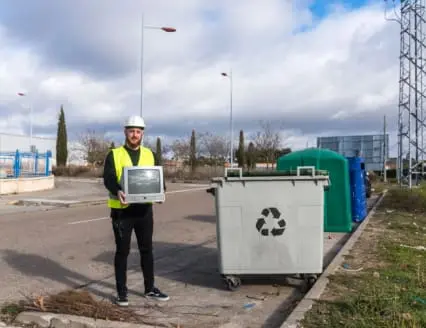What is E-Waste Management?
E-waste management refers to handling and managing electronic waste, such as phones, computers, tablets, and more. E-waste is currently the fastest-growing waste stream worldwide, which is why it’s important for us to find ways to manage the waste before it gets too late.
Over 50 million tons of e-waste are produced every year. And with electronics like cell phones becoming more and more popular, it’s easy to assume that this number will only rise as the years go by. This is why it’s important for us to start finding proper ways to manage our e-waste now before it becomes a bigger problem.
Nowadays, organizations are looking to manage e-waste through proper disposal methods, recycling, and even repairing faulty electronics to reduce the amount of e-waste produced.
Managing e-waste requires a multi-faceted approach that may look different for every company. So, it’s important to dive deep into your organization’s e-waste production to find the best approach to managing it.
Types & Examples of E-Waste
E-waste refers to any type of electronic waste that’s no longer wanted or needed. This encompasses a wide range of objects but can refer to things like cell phones, laptops, tablets, gaming consoles, televisions, and similar devices.
Nowadays, new technology is released almost every day, making old devices obsolete. This is the reason why we’re seeing a massive rise in e-waste that we need to start managing as soon as possible.
Aside from taking up a lot of space, e-waste can be hazardous. For example, many electronic devices contain elements such as lead and mercury to keep the electronics working. However, if you don’t dispose of the electronics properly, these elements could seep into the environment, damaging the ecosystem.
With more and more people using electronics and throwing away old models, now is the perfect time to strongly emphasize the importance of e-waste management.
Approaches to E-Waste Management
There are various approaches to e-waste management. But typically, these are divided into disposal and recycling methods. So, let’s get into these different approaches to understand how you can practice e-waste management in your organization.
Disposal Methods
There are four main methods of e-waste disposal. These are:
- Landfills – These are the most common option for managing e-waste, and they involve burying the waste in the ground. While convenient, it isn’t recommended as the waste releases toxic substances into the ground, contaminating the environment.
- Incineration – This involves converting e-waste into ash and gas by exposing it to very high temperatures. While it reduces the waste’s volume, it also releases toxic substances into the air, further polluting the environment.
Recycling Processes
Recycling is arguably the best way to manage e-waste. When waste is recycled, you reduce the amount of waste that ends up in incinerators and landfills. On top of that, it conserves natural resources by reducing the need for new raw materials. However, recycling can be a complex process, requiring specialized equipment and facilities and careful sorting and handling of e-waste.
Join the Revolution in E-Waste Management with SafetyCulture Today!
Eliminate manual tasks and streamline your operations.
Get started for FREEChallenges of Managing E-Waste
There are quite a few challenges to managing e-waste that make it hard for organizations to practice it. While these are difficult challenges, organizations must overcome them to establish an effective and efficient workflow for managing e-waste. Here are some of the key challenges in e-waste management that companies today face:
- Ignorance of the importance of practicing proper e-waste management within an organization
- Poor infrastructure for managing e-waste in certain areas
- Short lifespan of modern electronics
- Not enough regulations and enforcement by local authorities
E-Waste Management Regulations
To better combat the hardships that e-waste can bring, many countries and territories have established regulations around e-waste management that companies must follow. Regulations may vary depending on your state, country, or territory. However, here are some of the major regulations around e-waste management worldwide.
Environmental Protection Agency (EPA)
The Environmental Protection Agency in the United States has a set of e-waste management regulations in place for companies to follow. These regulations lay out proper ways of managing certain types of e-waste.
Additionally, different states have their own laws around managing e-waste which is important to read before assuming operations.
Waste from Electrical and Electronic Equipment (EU)
The equivalent regulation in the EU is called the Waste from Electrical and Electronic Equipment Rules or WEEE. These include figuring out the most efficient and environmentally friendly way to deal with electronics and e-waste.
Again, the exact regulations may vary from country to country, so make sure to read your territory’s specific laws around managing e-waste.




